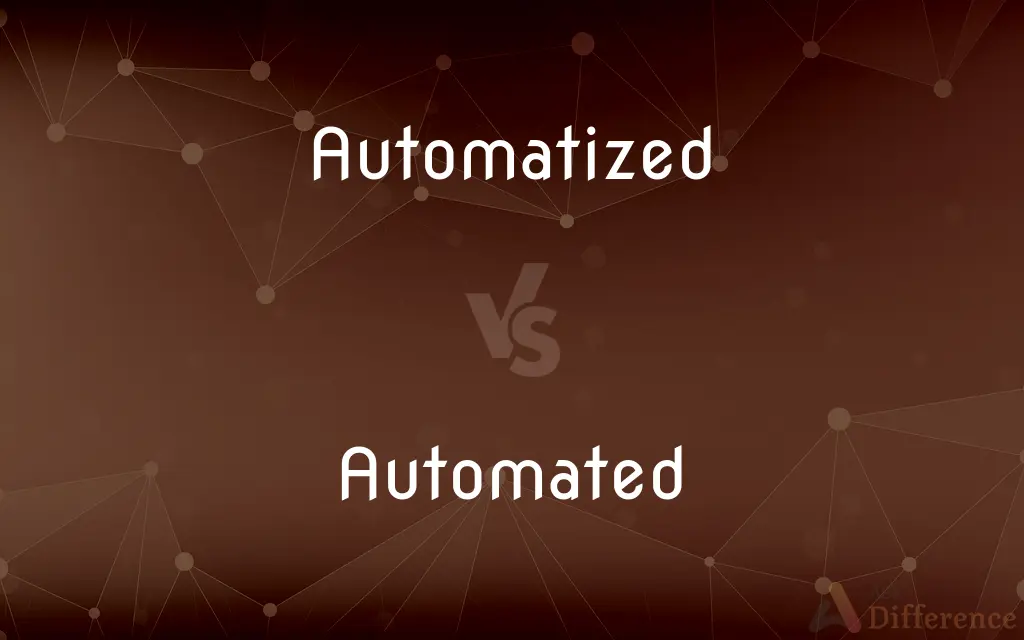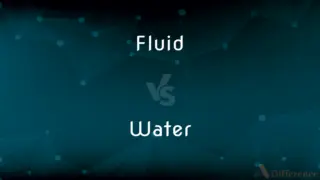Automatized vs. Automated — What's the Difference?
By Fiza Rafique & Urooj Arif — Updated on March 27, 2024
Automatized refers to making actions or processes second nature through practice, while automated involves using machines or technology to perform tasks without human intervention.

Difference Between Automatized and Automated
Table of Contents
ADVERTISEMENT
Key Differences
Automatization is the process of making an action or procedure become automatic through practice or habituation, leading to tasks being performed quickly and efficiently without conscious thought. On the other hand, automation refers to the use of technology, machinery, or systems to conduct tasks or processes with minimal or no human assistance, often in the context of manufacturing, software, or business processes.
While automatization typically involves cognitive or physical tasks becoming second nature to humans through repetition and practice, automation involves the design and application of technologies to replace human labor, focusing on efficiency, reliability, and scalability.
Automatization is often discussed in the context of learning and skill development, where repeated practice leads to a high level of proficiency, allowing individuals to perform tasks effortlessly and automatically. Conversely, automation is a key concept in industrial, technological, and business realms, aiming to improve productivity, reduce costs, and eliminate the potential for human error.
In the realm of psychology and cognitive science, automatization is a crucial concept for understanding how skills are acquired and how they evolve from requiring intense focus to becoming automatic. Automation, however, is a critical component of engineering and technology, emphasizing the creation and implementation of systems that operate independently of human control.
The goal of automatization is to enhance human performance and efficiency by internalizing and optimizing the execution of repeated tasks. Automation aims to complement or replace human efforts in various domains, leveraging technology to achieve outcomes that are either impractical or impossible for humans alone to accomplish.
ADVERTISEMENT
Comparison Chart
Definition
Making tasks automatic through practice or habituation.
Using machines or technology to perform tasks without human intervention.
Focus
Cognitive and physical tasks becoming second nature.
Technology and machinery replacing or aiding human labor.
Context
Learning, skill development, cognitive science.
Industrial, technological, business processes.
Goal
Enhance human performance and efficiency.
Improve productivity, reduce costs, eliminate human error.
Examples
Learning to type or drive without consciously thinking about actions.
Manufacturing robots, software algorithms managing data.
Compare with Definitions
Automatized
Involves cognitive or physical tasks.
Reading is an automatized skill that requires little conscious thought from adults.
Automated
Relates to technology performing tasks.
The factory introduced an automated assembly line to increase production.
Automatized
Pertains to the process of becoming automatic through repetition.
After months of practice, playing the piano became automatized for her.
Automated
Involves minimal human intervention.
Automated software updates occur without needing user action.
Automatized
Focuses on skill development.
Automatized skills allow athletes to perform complex movements effortlessly.
Automated
Applies to various industries.
Automated systems manage inventory in warehouses with high efficiency.
Automatized
Achieved through practice.
Through repeated exposure, language acquisition can be largely automatized.
Automated
Can replace or complement human labor.
Automated customer service tools can handle inquiries alongside human staff.
Automatized
Enhances human efficiency.
Automatized processes enable quick decision-making in experienced professionals.
Automated
Designed for consistency and accuracy.
Automated processes ensure uniform quality in manufacturing.
Automatized
To make automatic.
Automated
To convert to automatic operation
Automate a factory.
Automatized
To turn into an automaton.
Automated
To control or operate by automation.
Automatized
Simple past tense and past participle of automatize
Automated
To make use of or be converted to automation
A food service that decided to automate for greater efficiency.
Automated
Made automatic.
Automated
Done by machine.
Automated
Simple past tense and past participle of automate
Automated
Accomplished by machinary without the intervention of a human operator; - of processes.
Automated
Operated by automation;
An automated stoker
Common Curiosities
What are the benefits of automation?
Benefits include increased productivity, reduced human error, lower operational costs, and the ability to perform tasks beyond human capabilities.
What does it mean to automatize a skill?
Automatizing a skill means practicing it until it can be performed quickly and efficiently without conscious effort.
How does automatization affect learning?
It makes learned skills more efficient and less mentally taxing, allowing for multitasking and focusing on higher-order thinking.
How has automation changed the workforce?
Automation has shifted the workforce by reducing the need for manual labor in certain tasks while increasing the demand for tech-savvy professionals.
Can a process be both automatized and automated?
Yes, some processes involve both human skill automatization and the use of technology for automation, especially in complex tasks.
How do automatization and automation contribute to efficiency?
Both processes streamline operations—automatization by enhancing human skill efficiency and automation by performing tasks more swiftly and accurately.
What is the purpose of automation in industries?
The purpose is to increase efficiency, reduce labor costs, and improve reliability and accuracy in processes.
Is automatization only related to physical tasks?
No, it also includes cognitive tasks where decision-making and thought processes become more efficient and automatic with practice.
What role does technology play in automation?
Technology is central to automation, providing the tools and systems that perform tasks without direct human control.
Can automation negatively impact employment?
While automation can displace certain jobs, it also creates opportunities for new roles and industries, emphasizing the need for workforce adaptation.
Share Your Discovery

Previous Comparison
Fluid vs. Water
Next Comparison
Anger vs. HateAuthor Spotlight
Written by
Fiza RafiqueFiza Rafique is a skilled content writer at AskDifference.com, where she meticulously refines and enhances written pieces. Drawing from her vast editorial expertise, Fiza ensures clarity, accuracy, and precision in every article. Passionate about language, she continually seeks to elevate the quality of content for readers worldwide.
Co-written by
Urooj ArifUrooj is a skilled content writer at Ask Difference, known for her exceptional ability to simplify complex topics into engaging and informative content. With a passion for research and a flair for clear, concise writing, she consistently delivers articles that resonate with our diverse audience.















































